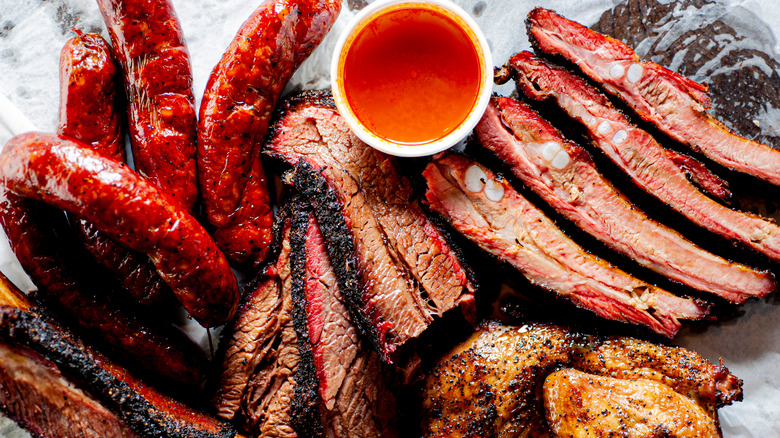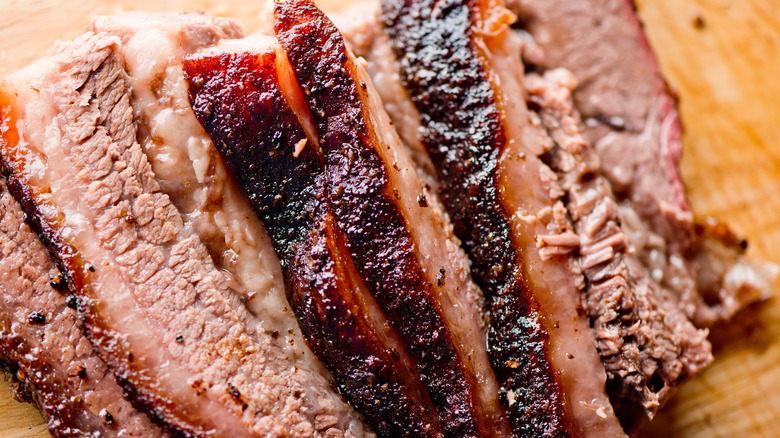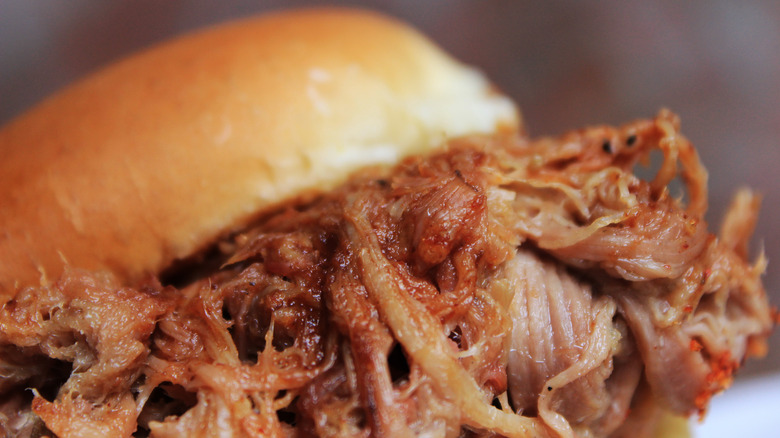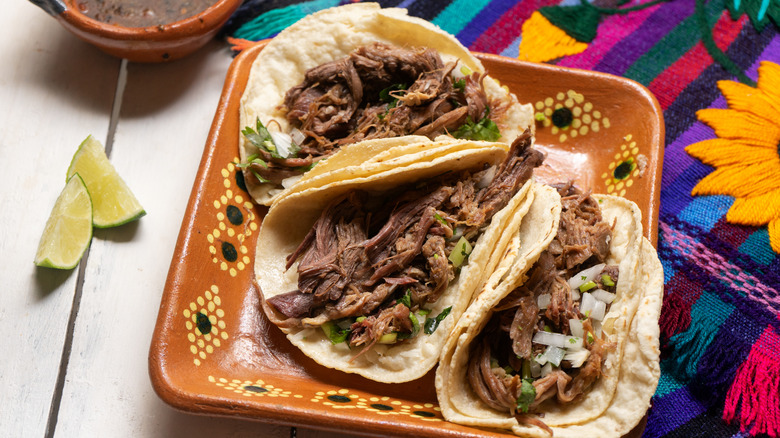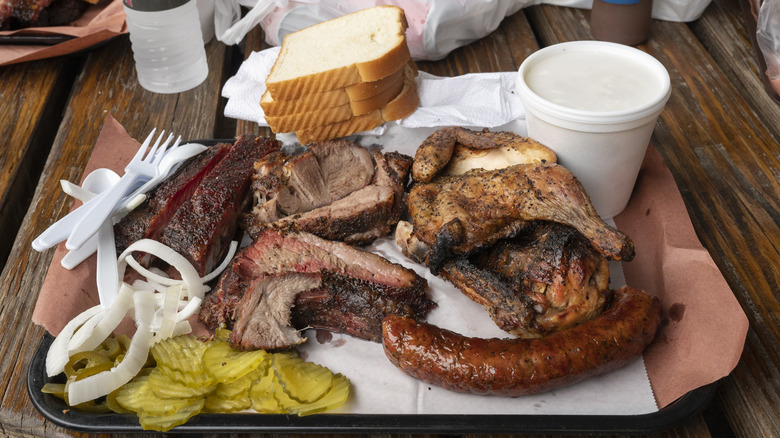The 4 Styles Of Texas Barbecue, Explained
Barbecue dependably captivates. Just the thought of some tender brisket, country-style ribs, and a potato salad can make one's mouth water. While there's delicious barbecue all around the U.S., five regions are especially celebrated, and one of them is Texas, per BBQ Revolution.
In fact, according to Texas Monthly, the Lone Star State is likely where barbecue was first sold in America. In 1878, a butcher in Bastrop, a town near Austin, released an advertisement for smoked meat. A decade later, the first Southside Market opened in the adjacent town of Elgin, and is still going strong, serving its famed hot sausage.
Over the next century, Texas barbecue has developed various, dazzling styles. For example, putting the meat above all else, most pitmasters eschew slathering BBQ sauce directly on cuts, instead serving it as a side, Britannica notes. The Lone Star style is also famous for its meat "trinity," which includes brisket, sausage, and pork ribs. However, such stylistic cues don't adequately summarize the state's offerings. In congruence with its large size, Texas is home to four regional sub-styles. Let's dive into the specifics of each.
Central Texas Style is all about slow-smoked brisket and sausage
When most say "Texas-style" barbecue, they really mean Central Texas-style meats. The oldest and most recognized variation is all about slow smoking, specifically brisket (via Thrillist). And pitmasters tend to keep it simple when seasoning the meat — using a rub of salt and black pepper, though some add an additional hint of spice. And the central focus is on the heat application, which can last as long as 20 hours over a hardwood fire. Post oak is the most common wood used, but mesquite, pecan, and hickory are also popular. The result is indescribable — moist and full of flavor, a Texas-style combo plate wouldn't be complete without at least one slice of the beef.
Sausage is the other cornerstone of Central Texas barbecue. A direct result of European immigration, these links use smoking and flavoring techniques common in Poland and the Czech Republic. Coarsely ground pork, sometimes some beef, garlic, and a rotating mix of spices are the core ingredients. Much like the brisket, Barbecue at Home explains that the sausage is slow-cooked over wooden chips.
In short, Central Texas barbecue is all about patience — including when trying to procure some to eat. The lines are often long at the James Beard award-winning restaurant Franklin Barbecue, but it's worth the wait.
East Texas Style serves slow-cooked meats in sandwiches with numerous sides
Drawn out, low-heat cooking is also the hallmark of East Texas barbecue, although this region is a little less purist when serving its meat. Rather than exclusively smoking, according to Red Hot & Blue, spices and tomato-based marinades impart much of the flavor. While slow-cooked brisket is popular here as well, pork shares the stage too. These techniques coalesce to make some incredibly succulent meat, which as Smoked BBQ Source notes, is typically chopped or pulled rather than sliced. To soak up all the juices, these meats are served in sandwiches.
You'll also find Cajun influences at East Texan barbecue joints. So don't be surprised if you see boudin, since Louisiana is just across the border. Boudin, according to Cajun Food Tours, is a seasoned pork sausage with rice and cooked peppers and onions. And per Let's Texas, the numerous sides get the Southern comfort treatment — delicious pan-fried okra, and classics regional desserts like banana pudding. So expect large quantities and variety when digging into an East Texas-style barbecue. At the famed Gatlin's BBQ in Houston, you can find classics like pulled pork and brisket, complete with sides like collard greens, mac and cheese, and even a BBQ-style gumbo.
South Texas barbecue takes on Mexican influences
Head further south towards the border, and Mexican techniques and flavors come to the fore. Guacamole and salsa replace barbecue sauce, and underutilized beef cuts like head and tongue are prepared barbacoa style, notes Dyer's BBQ. This cooking method, according to Thrillist, doesn't use grills or spits but a deep pit covered in rocks in which mesquite wood is burned down into charcoal. The beef is wrapped in agave leaves and buried overnight and left to cook for up to twelve hours. The result is unbelievably tender, as the meat falls off the bone right into tortillas, served with salsa, cilantro, and onion for amazing fajitas. In addition to cow head, whole goats are also popular barbecue proteins.
Just don't expect to find this style of barbecue easily. It mostly takes place in private backyards, and only on weekends. In fact, according to Texas Monthly, only one joint serves up the dug-out pit method in a commercial setting, and that's Vera's Backyard Bar-B-Que in Brownsville.
West Texas barbecue cooks many various meats over an open flame
The other styles in Texas favor slow cooking, but in West Texas, the meat is seasoned simply and placed directly on the flame, similar to grilling. Since this region is a desert, the wood options are limited. Mesquite is the only type of tree that grows here, so it is the fuel of choice, per MasterClass. As a result of the cooking method, there's a lot less smoke flavor; instead, the meat takes on the taste of the wood. And since brisket must be slow-cooked, you won't always find it in this area, but you can expect to find chicken, turkey, sausages, ribs, and more, all cooked up in the "Cowboy Style" technique, explains Red Hot & Blue.
The style also exhibits Mexican influence, as common sauces include chilies, spices, and a tomato base, via Dyer's BBQ. At the stellar Convenience West in Marfa, in addition to brisket, you will see pickled jalapenos, cornbread, and pork al pastor sausage — a real encompassing of Mexican-American influences, says Texas Monthly.
